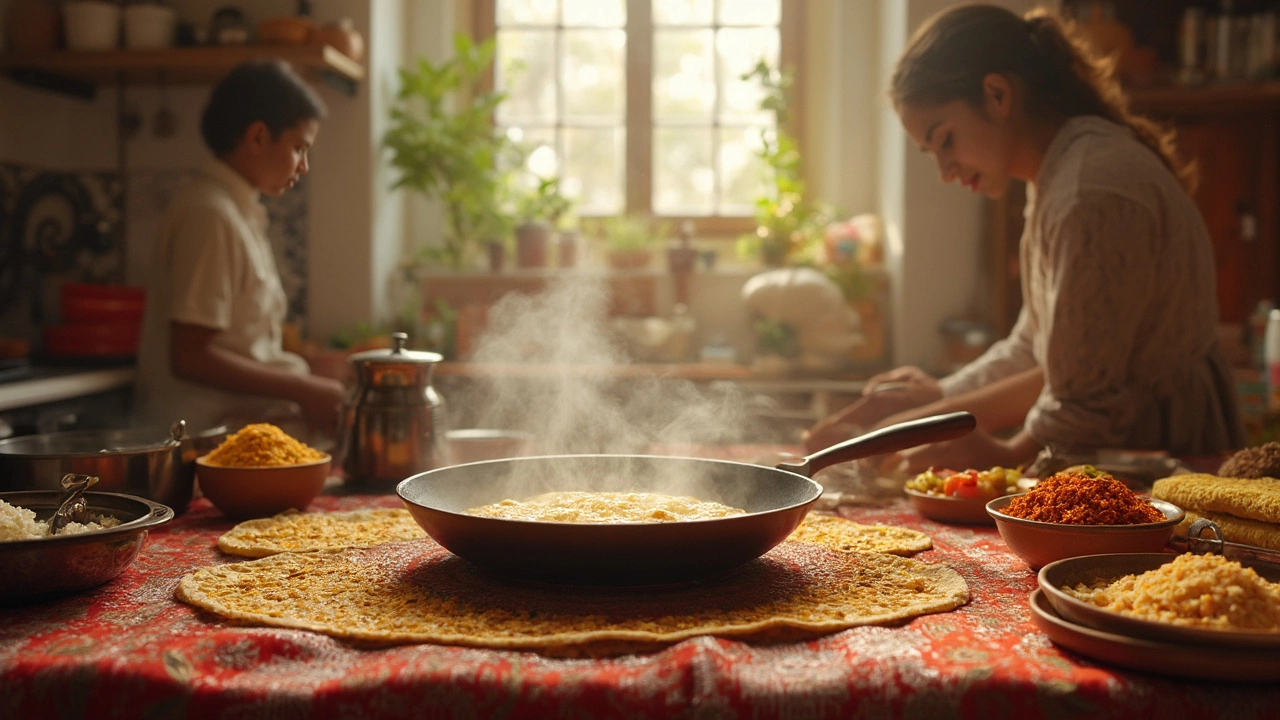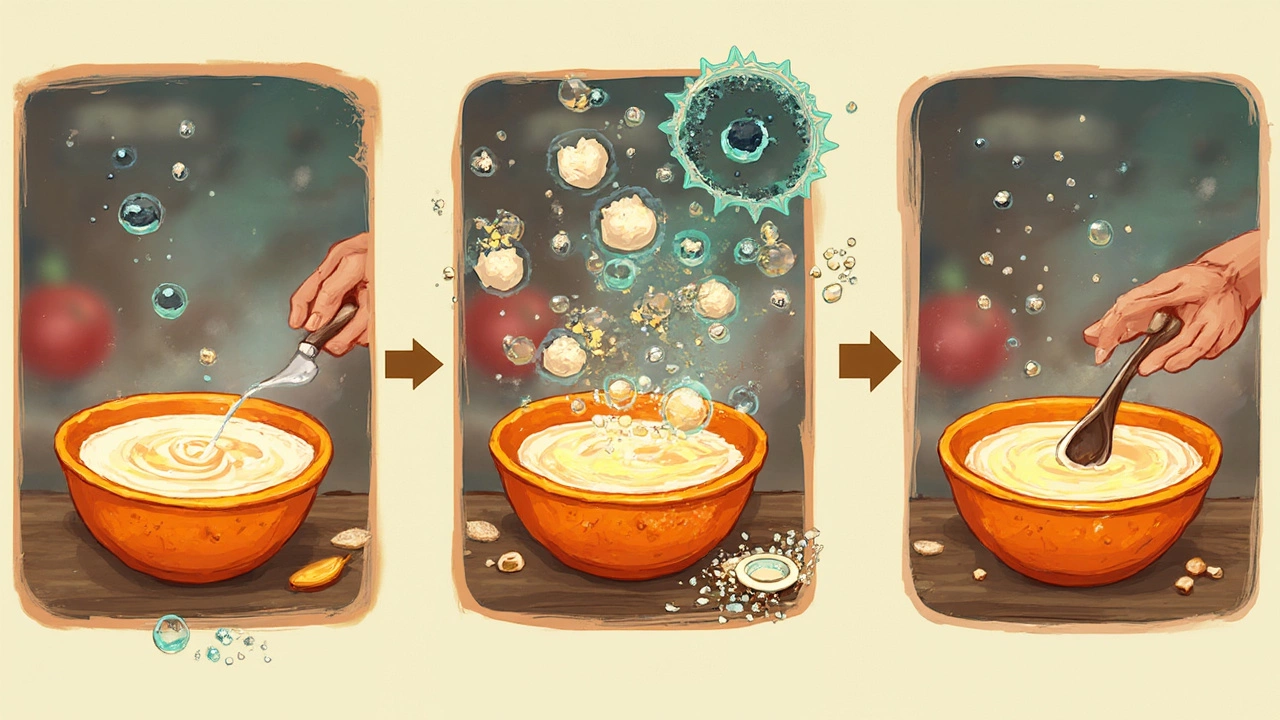Instant Dosa Batter: Fermentation Tips You’ve Been Waiting For
 Feb, 15 2025
Feb, 15 2025
Ever dreamed of making dosas as crispy as the ones in those killer South Indian joints, but don't have the luxury of time for a long fermentation wait? Then you might just find instant dosa batter to be your new best friend. But here's the deal: even with instant batter, a little understanding of fermentation can make a world of difference.
So what's the magic behind fermentation, anyway? It's basically the dance of yeast and bacteria that gives dosas their signature tang and fluff. But to really nail it, you have to get the conditions just right. A warm spot in your kitchen is key! Too hot, and you’ve got a sour mess; too cold, and nothing happens.
- The Science of Fermentation
- Perfect Conditions for Fermentation
- Boosting Fermentation with Secret Ingredients
- Maintaining Batter Quality
The Science of Fermentation
Ever wonder why your dosa batter needs to ferment in the first place? It's all about a fascinating mix of biological processes that give rise to those wonderful textures and tangy flavors. The heroes of this story are harmless bacteria known as lactic acid bacteria and wild natural yeast. These tiny microorganisms break down the sugars present in the batter, releasing carbon dioxide and producing lactic acid in the process.
This activity creates the slight sour taste we love in our dosas and, importantly, helps the batter rise, making it light and airy. Fermented dosa batter isn’t just about taste; it’s about getting that perfect crispy texture that makes each bite a delight. It’s also great for digestion, as these microbes break down the nutrients, making them more accessible for your body.
Fermentation Time and Temperature
One of the essential things to know is that fermentation depends heavily on temperature. Ideal fermentation happens between 25°C to 32°C (77°F to 90°F). You might not want to play Goldilocks here, but getting your environment 'just right' can make a real difference. If it's too cold, the batter may take eons to ferment. Too hot, and you risk it becoming too sour or even spoiling.
In cooler climates or seasons, it might help to keep your batter near a warm appliance like a microwave or oven, or even wrap it in a blanket. Just remember, keeping an eye on the time is as important as maintaining the right temperature. Typically, you'll want to let it sit for at least 8 hours, but it can go up to 12 or even 24 hours depending on the conditions.
How to Know If It's Done?
A properly fermented dosa batter will exhibit some crucial signs. It’ll have a slightly increased volume and might have a few bubbles on the surface. Most importantly, it’ll have that characteristic tangy aroma. And if you’re still unsure, a little taste test never hurt anyone, right?
| Temperature | Fermentation Time Range |
|---|---|
| 25°C - 28°C (77°F - 82°F) | 10 - 12 hours |
| 28°C - 32°C (82°F - 90°F) | 6 - 10 hours |
Perfect Conditions for Fermentation
If you want to get that dosa batter spot-on, you've got to play nice with the environment. Here's the scoop on creating the perfect fermentation conditions.
The Right Temperature
Temperature can make or break your batter. The sweet spot is between 25°C to 30°C (77°F to 86°F). This range gives the natural yeast enough warmth to thrive without overheating and going wild. In case you're dealing with colder climates, try placing the batter inside your oven with just the light on for a gentle warmth.
Avoiding Overcrowding
Fermentation needs space, so don't overfill your container. Leave about a third of your container empty to allow room for the batter to rise. This not only keeps things tidy but also provides the batter enough room for air circulation, which is crucial for the process.
Humidity Matters
Humidity can also impact fermentation. A dry environment can hinder the process. If you're somewhere arid, you might want to place a damp cloth over the container. This adds a hint of moisture, helping the good bacteria do their job.
Timing is Key
Timing depends a lot on your local conditions. On a warm day, it might take around 8-10 hours, and on cooler days it might stretch to 12 hours or more. For a quick test, take a small dollop of the batter and drop it in a cup of water. If it floats, you're golden—fermentation is complete!
With these tips, you've got everything you need to create the ideal conditions for that foolproof fermentation. Your instant dosa batter will have that just-right tanginess every time!

Boosting Fermentation with Secret Ingredients
Ever wondered if there’s a secret sauce to elevate your instant dosa batter fermentation? Well, grab a seat because we’re spilling some serious secrets.
Yeast: The Fermentation MVP
If you're in a rush and need those dosas pronto, sprinkling a tiny bit of yeast can give your batter the boost it needs. Just think of yeast as the party starter for your batter, kicking off fermentation and letting you savor that tangy taste much faster.
Poha (Flattened Rice) Magic
Crush some poha and mix it into your instant dosa batter. This isn't just grandma's trick – it’s science. The starches in poha convert into sugars which yeast loves, giving your batter the lift it sometimes needs, especially in those cooler months.
Methi Seeds Wonder
Methi seeds not only have health benefits, but they also help with fermentation. Before you soak your rice, add a teaspoon of methi seeds. They soften the batter, letting the microbes do their thing more effectively. And the hidden bonus? A slight, delightful bitterness that sharpens the flavor.
Keep It Natural with Curd
Adding a couple of tablespoons of curd can introduce good bacteria and speed up the fermentation process. Plus, the natural acids in curd balance out the flavor, giving your dosas that perfect tangy zing.
Sometimes the environment doesn’t play along with our cooking plans. When temperatures drop, even your best efforts can fall flat. That’s where these ingredients come to the rescue, ensuring your dosa batter is always on point. Don’t be afraid to experiment, because sometimes, the best dosas come from the boldest mixes!
Maintaining Batter Quality
Even with instant dosa batter, keeping your batter in tip-top shape is essential for those perfect dosas. How can you make sure your batter stays as good as new? Let's break it down.
Store Smart
Your fridge is your batter's best friend. The cool environment slows down fermentation and keeps the texture just right. Make sure to store batter in an airtight container to avoid drying out or absorbing any funky odors from other fridge items.
Stirring Matters
Every time you dip into the batter, give it a good stir. This keeps the fermentation uniform and helps maintain consistency throughout. Stirring is crucial because as the batter sits, the right amount of air helps maintain its fluffiness.
Quantity Check
Don’t let great batter go bad because you made more than you could handle. Always try to estimate the amount you'll use in a day or two, and batch it accordingly. If you're making for a large group, mark different containers with dates to keep track of how long they've been chilling.
Reinvigorate with a Pinch
If your batter starts acting all flat and lifeless, a tiny boost can help. Add a pinch of sugar and let it sit at room temperature for a bit. This tiny trick does wonders by giving the batter the jolt it needs to bounce back.
Waste Not
Got leftover batter getting old? Use it creatively for different pancakes or savory crepes. An adaptable cook can always find new ways to whip up something delightful!
By following these simple steps, you'll ensure that your dosa batter remains ready-to-go whenever you crave those delicious crispy circles. Happy dosa making!